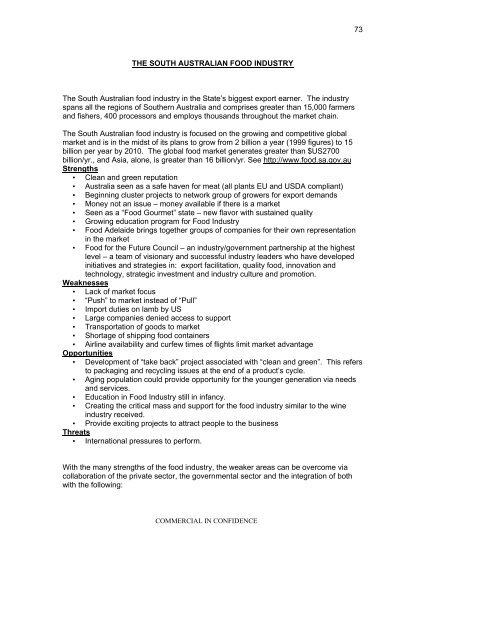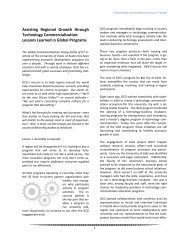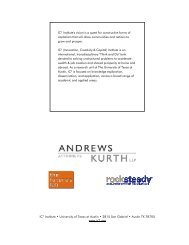“Quicklook” Assessment of Greater Adelaide's Assets & Challenges ...
“Quicklook” Assessment of Greater Adelaide's Assets & Challenges ...
“Quicklook” Assessment of Greater Adelaide's Assets & Challenges ...
Create successful ePaper yourself
Turn your PDF publications into a flip-book with our unique Google optimized e-Paper software.
THE SOUTH AUSTRALIAN FOOD INDUSTRY<br />
The South Australian food industry in the State’s biggest export earner. The industry<br />
spans all the regions <strong>of</strong> Southern Australia and comprises greater than 15,000 farmers<br />
and fishers, 400 processors and employs thousands throughout the market chain.<br />
The South Australian food industry is focused on the growing and competitive global<br />
market and is in the midst <strong>of</strong> its plans to grow from 2 billion a year (1999 figures) to 15<br />
billion per year by 2010. The global food market generates greater than $US2700<br />
billion/yr., and Asia, alone, is greater than 16 billion/yr. See http://www.food.sa.gov.au<br />
Strengths<br />
• Clean and green reputation<br />
• Australia seen as a safe haven for meat (all plants EU and USDA compliant)<br />
• Beginning cluster projects to network group <strong>of</strong> growers for export demands<br />
• Money not an issue – money available if there is a market<br />
• Seen as a “Food Gourmet” state – new flavor with sustained quality<br />
• Growing education program for Food Industry<br />
• Food Adelaide brings together groups <strong>of</strong> companies for their own representation<br />
in the market<br />
• Food for the Future Council – an industry/government partnership at the highest<br />
level – a team <strong>of</strong> visionary and successful industry leaders who have developed<br />
initiatives and strategies in: export facilitation, quality food, innovation and<br />
technology, strategic investment and industry culture and promotion.<br />
Weaknesses<br />
• Lack <strong>of</strong> market focus<br />
• “Push” to market instead <strong>of</strong> “Pull”<br />
• Import duties on lamb by US<br />
• Large companies denied access to support<br />
• Transportation <strong>of</strong> goods to market<br />
• Shortage <strong>of</strong> shipping food containers<br />
• Airline availability and curfew times <strong>of</strong> flights limit market advantage<br />
Opportunities<br />
• Development <strong>of</strong> “take back” project associated with “clean and green”. This refers<br />
to packaging and recycling issues at the end <strong>of</strong> a product’s cycle.<br />
• Aging population could provide opportunity for the younger generation via needs<br />
and services.<br />
• Education in Food Industry still in infancy.<br />
• Creating the critical mass and support for the food industry similar to the wine<br />
industry received.<br />
• Provide exciting projects to attract people to the business<br />
Threats<br />
• International pressures to perform.<br />
With the many strengths <strong>of</strong> the food industry, the weaker areas can be overcome via<br />
collaboration <strong>of</strong> the private sector, the governmental sector and the integration <strong>of</strong> both<br />
with the following:<br />
COMMERCIAL IN CONFIDENCE<br />
73





